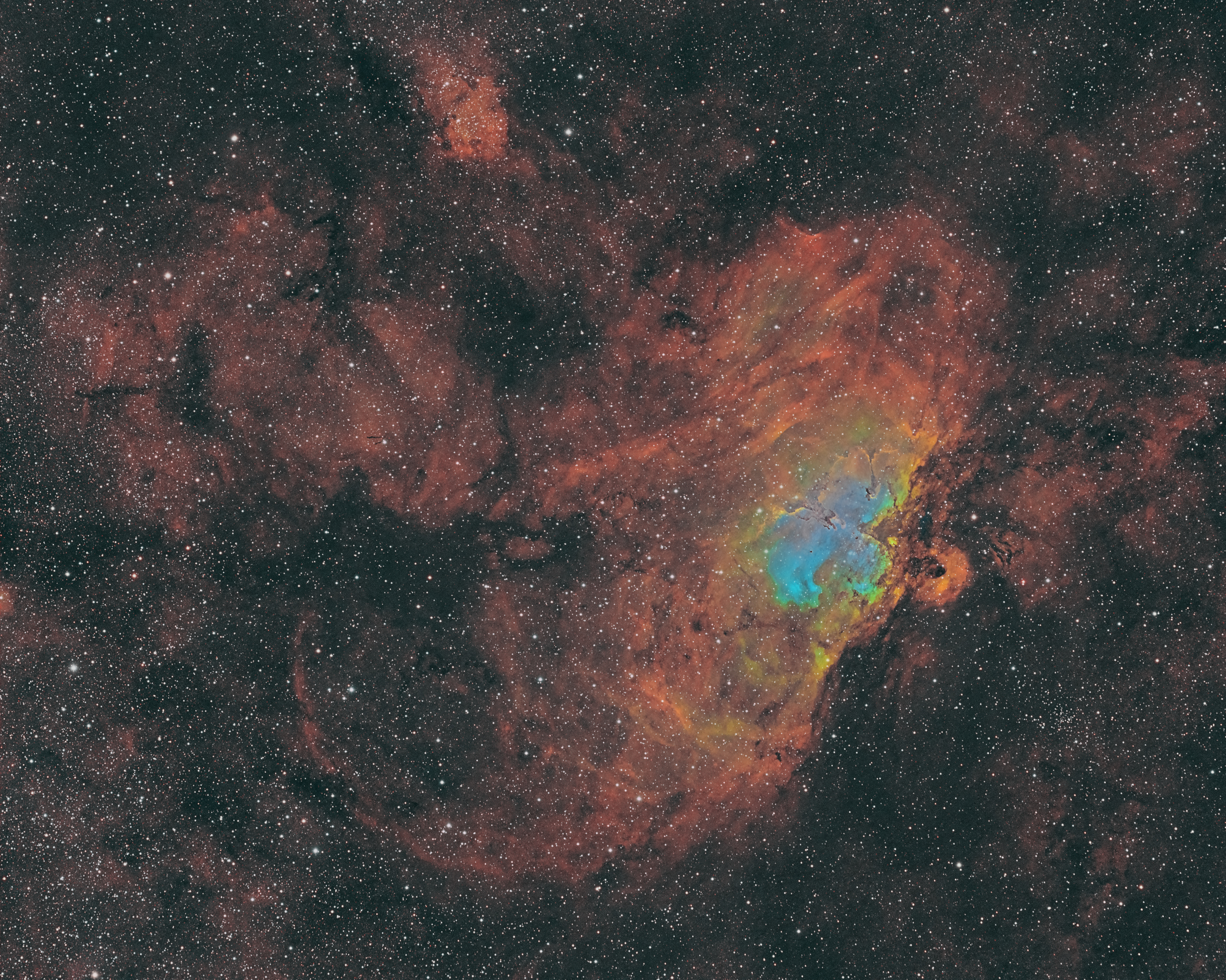M16 - AdlernebelM16 - Eagle Nebula
 Fahre mit der Maus über das Bild um es zu vergrössern
Move the mouse over the image to enlarge it
Fahre mit der Maus über das Bild um es zu vergrössern
Move the mouse over the image to enlarge it
 Klicke das Bild für eine grössere Ansicht an
Click the image for a larger view
Klicke das Bild für eine grössere Ansicht an
Click the image for a larger view
Der Adlernebel (katalogisiert als Messier 16 oder M16 und als NGC 6611, und auch bekannt als Sternenköniginnebel) ist ein junger offener Sternhaufen im Sternbild Serpens, der 1745-46 von Jean-Philippe de Cheseaux entdeckt wurde. Sowohl der "Adler" als auch die "Sternenkönigin" beziehen sich auf visuelle Eindrücke der dunklen Silhouette in der Nähe des Zentrums des Nebels, ein Gebiet, das als die "Säulen der Schöpfung", die vom Hubble-Weltraumteleskop abgebildet wurden, berühmt wurde. Der Nebel enthält mehrere aktive sternbildende Gas- und Staubregionen, darunter die bereits erwähnten Säulen der Schöpfung. Der Adlernebel liegt im Sagittarius-Arm der Milchstraße.
Der Adlernebel ist Teil eines diffusen Emissionsnebels bzw. einer H II-Region, die als IC 4703 katalogisiert ist. Diese Region mit aktiver Sternentstehung ist etwa 5700 Lichtjahre entfernt. Eine Gasspitze, die im nordöstlichen Teil des Nebels zu sehen ist, ist etwa 9,5 Lichtjahre oder rund 90 Billionen Kilometer lang.
Der zum Nebel gehörende Sternhaufen besteht aus etwa 8100 Sternen, die sich größtenteils in einer Lücke in der Molekülwolke im Nordwesten der Säulen befinden. Der hellste Stern (HD 168076) hat eine scheinbare Helligkeit von +8,24 und ist mit einem guten Fernglas gut sichtbar. Es handelt sich um einen Doppelstern, der aus einem O3,5V-Stern und einem O7,5V-Begleiter besteht. Dieser Stern hat eine Masse von etwa 80 Sonnenmassen und eine Leuchtkraft, die bis zu 1 Million Mal höher ist als die der Sonne. Das Alter des Haufens wird auf 1-2 Millionen Jahre geschätzt.
Die beschreibenden Namen spiegeln Eindrücke von der Form der zentralen Säule wider, die aus dem Südosten in den zentralen leuchtenden Bereich hineinragt. Der Name "Star Queen Nebula" wurde von Robert Burnham, Jr. eingeführt und spiegelt seine Charakterisierung der zentralen Säule als die in Silhouette dargestellte Sternenkönigin wider.
Quelle der Beschreibung: WikipediaThe Eagle Nebula (catalogued as Messier 16 or M16, and as NGC 6611, and also known as the Star Queen Nebula) is a young open cluster of stars in the constellation Serpens, discovered by Jean-Philippe de Cheseaux in 1745–46. Both the "Eagle" and the "Star Queen" refer to visual impressions of the dark silhouette near the center of the nebula, an area made famous as the "Pillars of Creation" imaged by the Hubble Space Telescope. The nebula contains several active star-forming gas and dust regions, including the aforementioned Pillars of Creation. The Eagle Nebula lies in the Sagittarius Arm of the Milky Way.
The Eagle Nebula is part of a diffuse emission nebula, or H II region, which is catalogued as IC 4703. This region of active current star formation is about 5700 light-years distant. A spire of gas that can be seen coming off the nebula in the northeastern part is approximately 9.5 light-years or about 90 trillion kilometers long.
The cluster associated with the nebula has approximately 8100 stars, which are mostly concentrated in a gap in the molecular cloud to the north-west of the Pillars. The brightest star (HD 168076) has an apparent magnitude of +8.24, easily visible with good binoculars. It is actually a binary star formed of an O3.5V star plus an O7.5V companion. This star has a mass of roughly 80 solar masses, and a luminosity up to 1 million times that of the Sun. The cluster's age has been estimated to be 1–2 million years.
The descriptive names reflect impressions of the shape of the central pillar rising from the southeast into the central luminous area. The name "Star Queen Nebula" was introduced by Robert Burnham, Jr., reflecting his characterization of the central pillar as the Star Queen shown in silhouette.
Source of description: WikipediaAufnahmedetails Acquisition details
Frames:
Aufnahmedauer insgesamt: Total integration time: 4h 50m
Verwendete Ausrüstung Equipment used